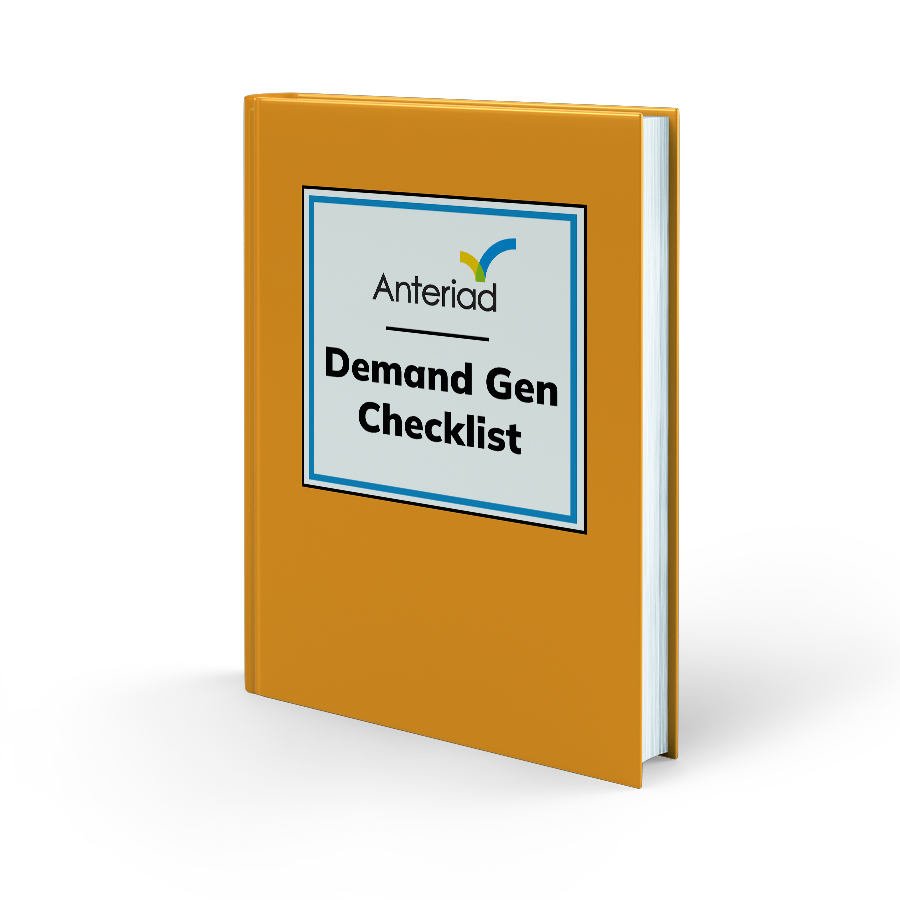B2B demand generation strategy checklist
We all face the same challenges when it comes to driving demand: we can develop great strategies, but budget and resource constraints often get in the way. You can get ahead of these challenges by following a few key steps to optimize your strategy. Use our checklist to build a winning B2B demand generation strategy.

Start with data to define your goals
- Review your annual goals and priorities. Be specific. Once you know what you’re trying to achieve, you can decide the best way to reach them.
- Assess historical performance to set realistic benchmarks. Strategic decisions should be guided by data not just gut feelings. Comb through your data to better understand how previous strategies have performed. Then look outward and research industry benchmarks to understand how you’re stacking up.
- Select 1-2 high-impact areas to focus your resources based on revenue potential and engagement trends. For example, identify underperforming channels with high traffic but low conversion rates, or accounts that frequently engage but do not progress in the funnel.
- Look across your channels and segments and identify where you are not meeting your goals. Areas that are underperforming should raise a red flag. You may be able to optimize for better results—or this could signal it’s time to shift away from these channels or segments entirely.
Set realistic KPIs that you can grow over time
- Choose 2-3 KPIs per focus area, ensuring they align with your overarching annual goals. For example: pipeline and revenue impact.
- Project what success looks like in one quarter, two quarters, and annually and make those your KPIs.
- Leveraging the industry benchmarks and historical success will help you validate any new KPI targets you set.

Identify your target audience
- Use your ideal customer profile (ICP) as your compass for audience targeting. This will help you set audience parameters on characteristics and buying behavior.
- Leverage first-party and third-party intent data to identify the most promising prospect accounts. If you’re not already using intent data, this is a great opportunity to. Find a trusted data provider, like Anteriad, to help you get started. Learn more about intent data strategies here.
- Partner with sales to prioritize high-intent and high-value accounts. Focusing on accounts showing high intent helps you get the most out of your budget because you know you’re marketing to people who are already in the market.
- Review accounts that may be coming back to your site multiple times but haven’t engaged yet. Hint: These accounts are showing intent. Consider adding them into retargeting campaigns to help them engage.
- Use predictive analytics to anticipate account movement within your funnel. Leverage engagement signals and intent data, while machine learning models can identify patterns and forecast next steps.
Define the customer experience
- Use existing data to pinpoint the channels and content to create unique customer experiences aligned with solving their individual needs.
- Segment messaging based on persona and where a prospect is in their buying journey for better personalization. For example, tailor content for decision-makers with ROI-focused messaging, while providing technical buyers with detailed feature comparisons. Use behavioral data to adjust messaging dynamically based on engagement patterns. (New)
- Create new and repurpose existing content with SEO best practices in mind. A/B test your content message and landing page UX.
- Ensure that the content you are putting into your channels matches the audience’s expectations at each touchpoint.
- Ungate your content. Use your web tools and marketing/sales tech stack to identify accounts and their behavior, ensuring a balance between engagement and conversion.

Run your campaign
- Set up your measurement tools (Google Analytics, Marketo/Eloqua/HubSpot dashboards, AI-driven insights platforms, and customer journey analytics tools) and keep them updated to track multi-touch engagement and campaign effectiveness. If you’re team has too much on their plate to manage this on top of everything else, a solutions provider can do this for you, offering reporting and insights to optimize performance.
- Define attribution models to understand multi-touch engagement. Assign point values to different touchpoints along the customer journey to determine which channels contribute the most to driving conversions and reaching your goals.
- Put your content into market through your channels, prioritizing high-performing B2B platforms like LinkedIn, programmatic advertising, and intent-based content syndication to maximize engagement and lead quality. (Updated) See how content syndication drives engagement.
- Gather data to determine what worked and what didn’t – and, most importantly, why.
Optimize and scale
- Use the data from your measurements to adjust your channels and tactics where you didn’t meet your goals.
- Continue doing what works and continue to refine your audience segmentation by leveraging engagement data, behavioral insights, intent data, and predictive analytics. Try using advanced personalization strategies, such as personalized landing pages, intent-based nurture streams, and dynamic content, to improve customer experience and boost conversions.
- Add new channels for scale based on proven engagement metrics.
- Run for another quarter with iterative improvements.

Identify your next area for funnel optimization
- Find prospects who have moved successfully through the current funnel stage and repeat the above steps to create a campaign that moves them to the next stage.
- Identify where you aren’t realizing your conversion metrics and repeat the above steps to create a new experience.
- Align funnel optimizations with revenue impact to maximize marketing contribution.
- Ready to grow how you measure your impact? Consider how marketing lift could change the way the business looks at your efforts.
Looking forward
By following this process, you will have a repeatable path to demand success. Because your business is unique, some of the steps outlined will be more important than others, but whatever your needs, ensuring each step is taken will guide the planning and execution of your demand generation programs.
To learn more, keep exploring the How to Develop a Demand Strategy guide.
Checklist: How to Develop a Demand Strategy

We all face the same challenges when it comes to driving demand: we can develop great strategies, but budget and resource constraints often get in the way. However, there are proven measures to help ensure success.
When creating your strategy:
Start with data to lay out your goals
- Look across your channels and segments and identify where you are not meeting your goals.
- Select 1-2 of those deficient areas to focus your resources.
Set realistic KPIs that you can grow over time
- Choose 2-3 KPIs per area you are looking to improve.
- Project what success looks like in one quarter, two quarters, and one year and make those your goals.
Identify your target audience
- Leverage intent data and partner with sales to identify the most promising prospect accounts.
- Review accounts that may be coming back to your site multiple times but haven’t engaged yet.
Define the customer experience
- Use existing data to pinpoint the channels and content to create the experience you want for your prospects.
- Create/repurpose content.
- A/B test your content message.
- Ensure that the content you are putting into your channels match the on-page landing experience.
- Ungate your content; leverage your web tools and marketing/sales tech stack to identify accounts and their behavior.
Run your campaign
- Set up your measurement tools (Google Analytics, Google Data Studio, Marketo/Eloqua dashboards, etc.) and keep them updated.
- Put your content into market through your channels.
- Gather data to determine what worked and what didn’t – and why.
Optimize and scale
- Use the data from your measurements to adjust your channels and tactics where you didn’t meet your goals.
- Continue doing what works and grow your target audience and customer experience
- Add new channels for scale.
- Run for another quarter.
Identify your next area for funnel optimization
- Find prospects who have moved successfully through the current funnel stage and repeat the above steps to create a campaign that moves them to the next stage.
- Identify where you aren’t realizing your conversion metrics and repeat the above steps to create a new experience.
By following this process, you will have a repeatable path to demand success. Because your business is unique, some of the steps outlined will be more important than others, but whatever your needs, ensuring each step is taken will guide the planning and execution of your demand programs.
To learn more, read our ebook, How to Develop a Demand Strategy.
